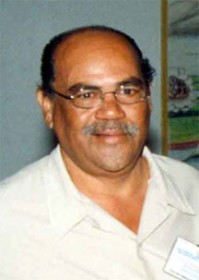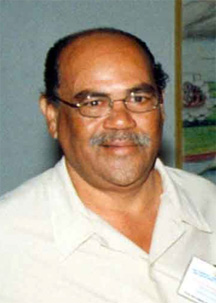– but sector stability threatened by land appropriation crisis, Shields says
Even as Guyana’s gold production seems set to exceed 300,000 ounces for the second consecutive year, controversies between Amer-indian communities and miners over mining rights in several of the country’s well-known gold-bearing areas have triggered a crisis that threatens to viability of the industry, Executive Secretary of the Guyana Gold and Diamond Miners Association (GGDMA) Edward Shields has said.
Shields claims that there are current cases in which Amerindian communities, seemingly with official blessing, have been asserting control of large tracts of lands that include claims legitimately held by miners, in some cases, forcing the miners to cease operations. “I believe that it would be fair to say that the situation amounts to a crisis,” Shields said in an interview with Stabroek Business earlier this week.

According to Shields, while gold production this year could reach “a possible 325,000 ounces,” higher gold yield could be stymied by increasing controversy resulting from what miners feel is an officially sanctioned but legally questionable posture by officials in some Amerindian communities that challenge the right of some miners to hold and operate legitimate mining claims. “One of the consequences of what obtains at this time is that some of the sizeable investors and potential investors in the industry are uncertain as to how to deal with the situation. There is a very real fear that investment in the industry could suffer as a result of this development,” Shields told Stabroek Business. And while Shields says that the mining community must continue to recognise and respect both the rights of Amerindians as well as regulations governing a responsible environmental regime in mining operations, he insists that the gold industry, given its importance to the national economy, must be allowed to operate in an environment in which legally held claims are recognised and mining is allowed to proceed without the threat of disruption resulting from acts that transgress both national laws and established mining regulations. “At the moment we have a situation in which less than 40,000 Amerindians control about 20% of the entire country. Of course we need to respect the rights of Amerindians but we must do so while being mindful of the need to responsibly sustain an industry that has become vital to the country’s economy,” Shields said.
“We note that there is one Toshao who has said that his village has been granted title for more than 33 square miles and has admitted that it will take at least 200 years for them to put that amount of land to effective use,” Shields said. The GGDMA secretary also cited what he said was a situation that obtained at Tassarine, an Amerindian community in the Issano area in which the community had been granted an extension of their jurisdiction “to take in a number of large and well-known mineralized areas. The fact is that in this particular case, a few thousand people will be controlling a land mass that is larger than most of the islands in the Caribbean,” he told Stabroek Business.”
Shields said that what concerned the mining industry most was the lack of effective enforcement of laws governing the rights of Amerindian communities. “When they are granted titles those titles specifically exclude lands that are legally held and occupied. In fact, the Lands and Surveys Department has specifically confirmed that there ought to be no misunderstanding of that statement. However, the Ministry of Amerindian Affairs appears to have a different understanding of the regulations,” he said.
Meanwhile, Shields said the response of the Guyana Geology and Mines Commission (GGMC) to the situation further compounds the problems faced by the miners. “There have been cases in which the GGMC has been refusing to accept rentals from those persons who have legitimate claims. As a consequence they claim that these areas have been abandoned.” Shields told Stabroek Business that the GGDMA was of the view that the GGMC was powerless to apply existing mining laws and regulations to put an end to the situation since it appeared that those Amerindian communities that had now assumed an assertive posture in relation to jurisdiction over lands may be acting with support from “higher authority.”
According to Shields, there are current cases in which the leadership of some Amerindian communities had “refused to acknowledge the authority of the GGMC and are operating without licenses or without the permission of the GGMC,” granting mining permission to other operators or themselves setting up such operations. Shields related a recent incident in which he said that a team of GGMC officials, including the commissioner had been told by the Toshao during a recent visit to Kamarang that they had not been given permission to visit the area and that in the future they would have to seek and secure permission before undertaking such visits. “GGMC, of course, has a duty to monitor and inspect operations in the various mining areas of the country and they must be able to do so without hindrance,” he added.
Shields told Stabroek Business that the association had learnt that government was currently reviewing the situation in relation to sub-surface rights that may result in such rights being granted to the Amerindians. “This is a constitutional issue since it is acknowledged, not only in Guyana but all over the world that sub-surface rights belong to all the citizens of a country. The mineral rights are the endowment of all Guyanese,” Shields said.
The GGDMA official drew attention to what he described as “a serious situation” at Tassawini in which several years ago a miner had bought a property for US$100,000 and had invested billions of dollars in the property only to be confronted with a situation in which the Amerindians in the area are seeking the removal of the miner from the property. Shields said the association was “deeply concerned” that such actions will become more frequent and that the GGDMA may have to move to the courts to resolve those issues. He said that he was aware of a recent similar case at Isseneru in which one miner had taken legal action resulting in the court upholding his right to mine. “In fact the courts have already pronounced to the effect that once a person has a license to mine they have a right rather than a privilege,” Shields said.
Meanwhile, Shields told this newspaper that the GGDMA believes that the actions of some Amerindian leaders amount to a slap in the face of government since the manner in which they were treating with jurisdiction over lands and the setting up of mining operations suggested that they were a law unto themselves. “It is obvious from what is happening in some situations that they do not consider themselves as requiring permission to do anything nor do they need to be told how to do things,” Shields said.
And the GGDMA Executive Secretary is calling for greater official and national recognition of the “critical contribution” that the gold mining sector continues to make to the national economy in the face of the challenges facing bauxite and sugar, the country’s traditional major money earners. He said that apart from the millions of dollars of earnings from the gold sector continuing to be used to build and upgrade interior roads, it had come to the attention of the GGDMA that monies from the mining industry will be used “to subsidize the sugar workers”. Shields said he believed the mining industry deserved official assurances that its contribution to the economy was recognized and that such assurances should manifest themselves in the form of action designed “to ensure that no undue impediments were placed in the way of ensuring the continuity and good health of the industry.”

